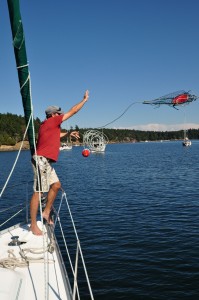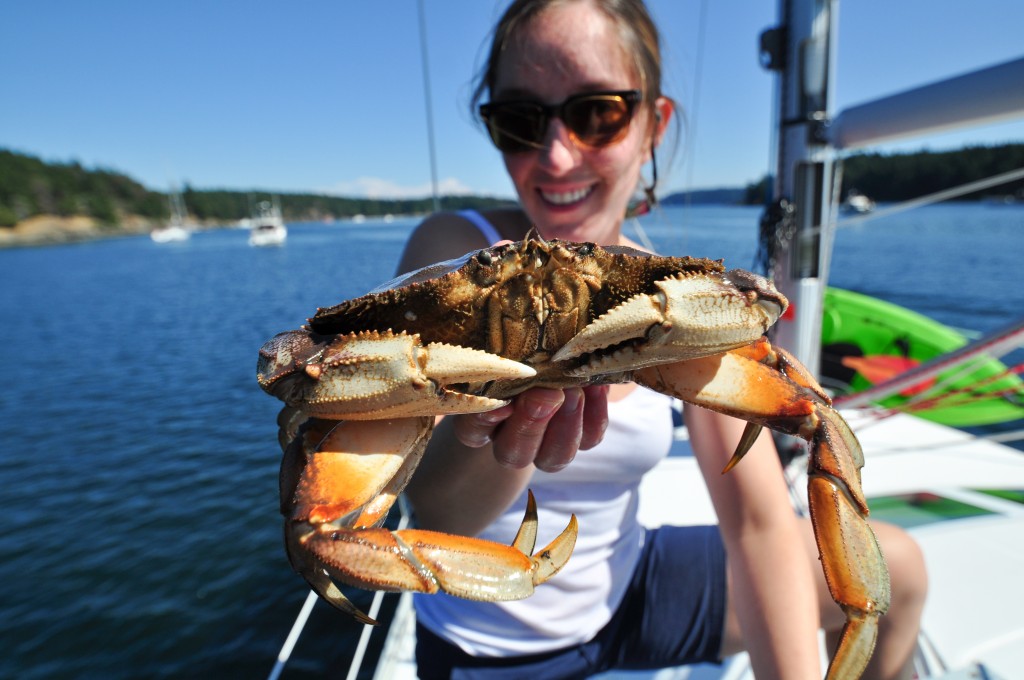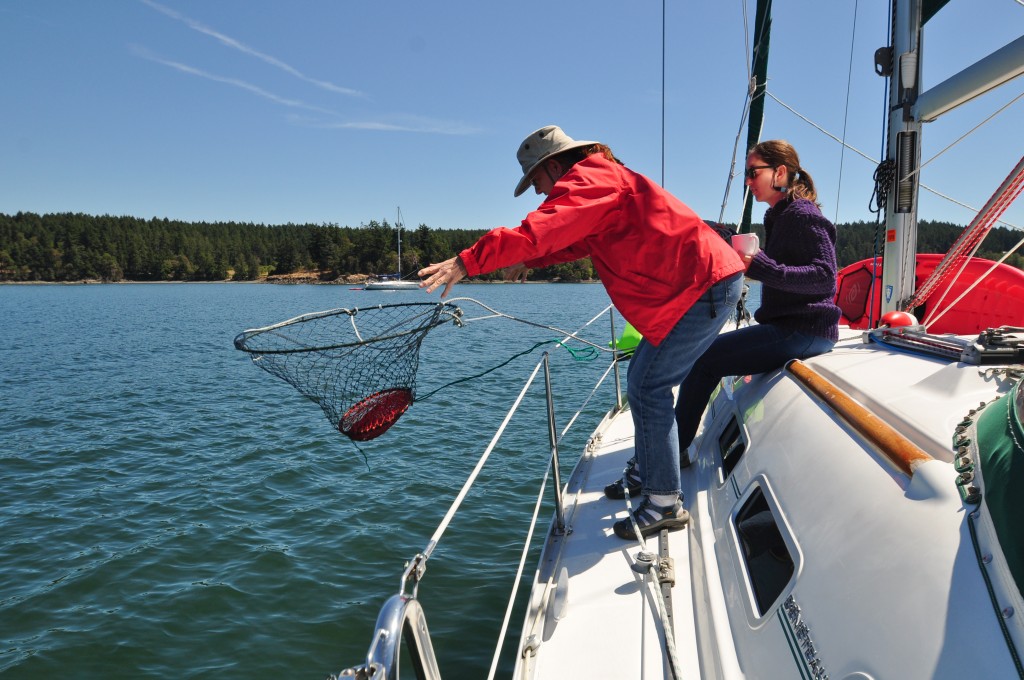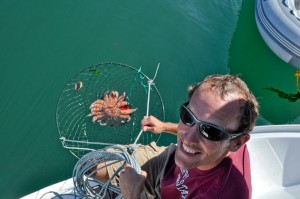The night before our San Juan sailing trip, we were stocking up on provisions at the Bellingham Trader Joe’s Supermarket. As we entered the store, a stock boy accidentally cut through a bag of frozen chicken breasts and spilled them all over the floor. The gods were smiling upon us. Why? Because one man’s trash is another man’s free crab bait.
As it turns out, Pacific Northwest crab love chicken.
The clean, clear waters around the San Juan Islands are ideal habitat for Pacific Northwest Dungeness and Red Rock Crab. They’re easy to catch if you have a little basic knowledge and the right equipment. Amanda and I had never done any serious crabbing, but necessity is the mother of motivation, and we soon learned how to net our own crab claw dinner.
Here’s what we learned along the way:
There are two basic methods for crabbing off a boat. For simplicity, I’ll call them “passive” and “active.” Both methods use a mesh bag of bait that allows the crab to smell and nibble on your rotting chicken (or fish heads, or squid). They all have lines to the surface with a red and white buoy marking the spot where you placed your trap.
 Passive traps are generally cages – smaller versions of the ones you see on The Deadliest Catch. Essentially, you bait the inside of the cage and let the trap sit on the bottom for several hours. Crab can get inside but not out, so when you’re ready for dinner, you cruise by in your dingy and pull it up.
Passive traps are generally cages – smaller versions of the ones you see on The Deadliest Catch. Essentially, you bait the inside of the cage and let the trap sit on the bottom for several hours. Crab can get inside but not out, so when you’re ready for dinner, you cruise by in your dingy and pull it up.
The upside to this method is that you can let the trap sit on the bottom for long periods of time, and you snag whatever crab happen to crawl inside. The downside is cost – they’re about two to three times more expensive than active traps, and if you pick a bad spot, you waste a whole day catching absolutely nothing.
Active traps feel much more like fishing. These are usually called star traps or ring nets. Both lie flat on the bottom until you pull up the line. A star trap closes in such a way that it forms a lid, while a ring net forms a basket shape when you pull. As long as you keep pulling, the crab won’t escape. Another plus: they’re small enough that you can pull them up from a kayak.
The downside to this method is that you can’t put a trap out all day – you have to check it regularly but it only takes 20 minutes (or about as long as it takes to finish a beer) for the crab to find your bait, so you have the joy of checking your trap often throughout the day. This also allows you to probe different spots to see where the crab hang out.
When we sailed into a bay, we would start by throwing the trap right off the boat. We were told that crab like 30 feet of water with a muddy bottom, which was the same terrain as most of our anchorages. If results were poor we would try different parts of the bay (taking note of where the locals placed their pots). We generally found that the most popular moorages landed us nothing but undersized males and females, while the least popular locations were easy pickings.
The first time we set our pot we tried lashing it to the back of the boat, but we swayed on our mooring line so badly that we disturbed our pot. After that, we let the buoy float freely.
We also found that we never caught anything in 40+ feet of water or around dusk. Over the course of 4 days we caught approximately 40 crab in 4 different locations. Of that total we were able to keep about 8 Red Rock Crab and 3 Dungeness. We also caught 3 huge starfish which were a delight to see come up, but absolutely not worth eating.
So yes, it’s a lot of work to catch your dinner, but nothing beats boiling up a fresh meal you landed only minutes before.
As for the differences between the crab? The Dungeness were superior in their flavor but harder to catch. Red Rock crab were smaller and more common (you can also take the females) but the meat was almost equally delicious.
If You Go:
You must obtain a license before you go crabbing.
Gear can run you about $200 if you buy everything new. Many charter boats have active traps included on board.
Dungeness can only be taken if they are males above 6 ¼ inches across the shell. Limit 5 males per day. You must record your catch and send it into the Washington Department of Fish and Wildlife. Red Rock Crab can be either sex, and only 5 inches. Limit 6 per day.
To cook your crab, boil them in a large pot along with a sprinkling of crab boil flavoring and salt for around 5 minutes and then let them sit for 15 minutes as the water cools.
Crabbing season in the San Juan Islands runs July 15 to September 30th on Thursday through Monday.



